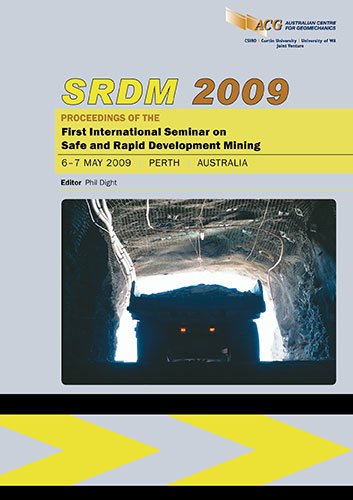Safer, deeper, faster: sprayed concrete — an integral component of development mining

|
Authors: Rispin, M; Howard, D; Kleven, OB; Garshol, K; Gelson, J |
DOI https://doi.org/10.36487/ACG_repo/902_07
Cite As:
Rispin, M, Howard, D, Kleven, OB, Garshol, K & Gelson, J 2009, 'Safer, deeper, faster: sprayed concrete — an integral component of development mining', in PM Dight (ed.), SRDM 2009: Proceedings of the First International Seminar on Safe and Rapid Development Mining, Australian Centre for Geomechanics, Perth, pp. 69-80, https://doi.org/10.36487/ACG_repo/902_07
Abstract:
It is a fact that underground mine workings are going deeper in the quest for ore reserves. This carries with it the need to develop workings under increasingly challenging environments with unprecedented economic and business pressures in the face of rising costs and high demand expectations. While sprayed concrete (wet shotcrete) has established itself globally over the last 15 years as a preferred means of ground support, there are still significant opportunities for greater penetration from this versatile and effective ground support medium. It not only allows more rapid and safe development but further offers downstream benefits in the form of longevity, effectiveness and reduced rehabilitation requirements. Stepwise improvements in the form of mix designs, admixtures and accelerators, equipment and expertise have yielded benefits in the form of early re-entry, logistics optimisation and effectiveness of application. Sprayed concrete has also proven itself as an attractive component of support systems in ductile environments. This paper will cover the requirements of a successful sprayed concrete program from a holistic approach; reference a suitable case study, emphasising the contribution to safe and rapid development; and discuss current pertinent benefits and challenges for its use in the global mining industry in the 21st century.
References:
Bernard, E.S. (2007) Early-age load resistance of fibre reinforced shotcrete linings, Tunnelling and Underground Space
Technology, 23, pp. 451–460.
Clements, M.J.K. (2004) Comparison of methods for the early age strength testing of shotcrete, Proceedings of 2nd
International Conference on Engineering Developments in Shotcrete, E.S. Bernard (ed), Cairns, Australia,
Taylor and Francis Group, London, pp. 81–89.
Knight, B., Rispin, M. and Clegg, I. (2006) Wet-Mix Shotcrete as a Material, Process, and Ground Control Component
of a 21st Century Underground Mining Operation; Proceedings of the 10th International Conference Shotcrete
for Underground Support, D.R. Morgan and H.W. Parker (eds), Whistler, Canada, Reston, VA: ASCE/ECI,
pp. 298–306.
Marvel Loch
0
100
200
300
400
500
600
700
Ap
r-
06
M
ay
-0
6
Ju
n-
06
Ju
l-0
6
Au
g-
06
Se
p-
06
O
ct
-0
6
No
v-
06
De
c-
06
Ja
n-
07
Fe
b-
07
M
ar
-0
7
Ap
r-
07
M
ay
-0
7
Ju
n-
07
Ju
l-0
7
Au
g-
07
Se
p-
07
O
ct
-0
7
No
v-
07
De
c-
07
Ja
n-
08
Fe
b-
08
M
ar
-0
8
Ap
r-
08
M
ay
-0
8
Ju
n-
08
Ju
l-0
8
Au
g-
08
Se
p-
08
Metres Fibrecrete M/Jumbo
M
et
re
s
of
d
ev
el
op
m
en
t
© Copyright 2025, Australian Centre for Geomechanics (ACG), The University of Western Australia. All rights reserved.
View copyright/legal information
Please direct any queries or error reports to repository-acg@uwa.edu.au
View copyright/legal information
Please direct any queries or error reports to repository-acg@uwa.edu.au